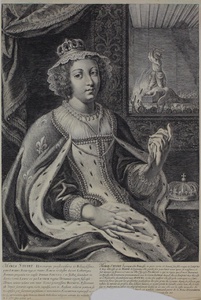| Method | Copper engraving |
| Artist | Jean Couvay |
| Published | [c. 1650] |
| Dimensions | Image 360 x 275 mm, Sheet 430 x 294 mm |
| Notes |
A rare three quarter length portrait of Mary, Queen of Scots, seen seated and turned slightly to the right, but facing forward. She is wearing a gown over lace ruff and sleeves, with a jewelled bodice, and ermine lined robes, brocaded with fleur-de-lis. On top of her short curled hair she bears a lace cap and a crown. Her right hand is resting on her lap, while she is holding a handkerchief in her left hand and pointing up towards a painting in a decorative frame, depicting her own future execution, with a cheering crowd watching as the executioner is about to swing his axe and behead the female figure lying on the block. Inscription to bottom margin: "Maria Stvart Heroinarum ... [quar]ante six ans." Mary, Queen of Scots (1542 - 1587), also known as Mary Stuart, or Mary I of Scotland, was Queen of Scotland between 1542 and 1567, and between 1559 and 1560, was Queen consort of France. She was the only surviving legitimate child of King James V of Scotland, and when she was only six days old, her father died, meaning that she acceded to the throne. Spending most of her childhood in France, Scotland was ruled by regents. In 1558, she married Francis, Dauphin of France. When he ascended the French throne as King Francis II the following year, Mary became queen consort of France. He died in 1560, and a widowed Mary returned to Scotland. In 1565, she married her first cousin, Henry Stuart, Lord Darnley. Their marriage was unhappy, and two years later, Darnley was murdered following an explosion at his residence. Despite James Hepburn, 4th Earl of Bothwell, widely being acknowledged as having planned Darnley's death, he was acquited, and Mary went on to marry him in 1567. After abdicating as the ruler of Scotland in favour of her husband, James, Mary travelled south to seek protection from her cousin, Queen Elizabeth I of England. Mary was later executed when she was found guilty of plotting to assassinate Elizabeth for the throne. Jean Couvay (c. 1605-1663) was a French printmaker active in Arles and Paris. O'Donoghue 110 Condition: Loss to bottom of inscription. Slight overall time toning. |
| Framing | unmounted |
| Price | £250.00 |
| Stock ID | 46867 |

